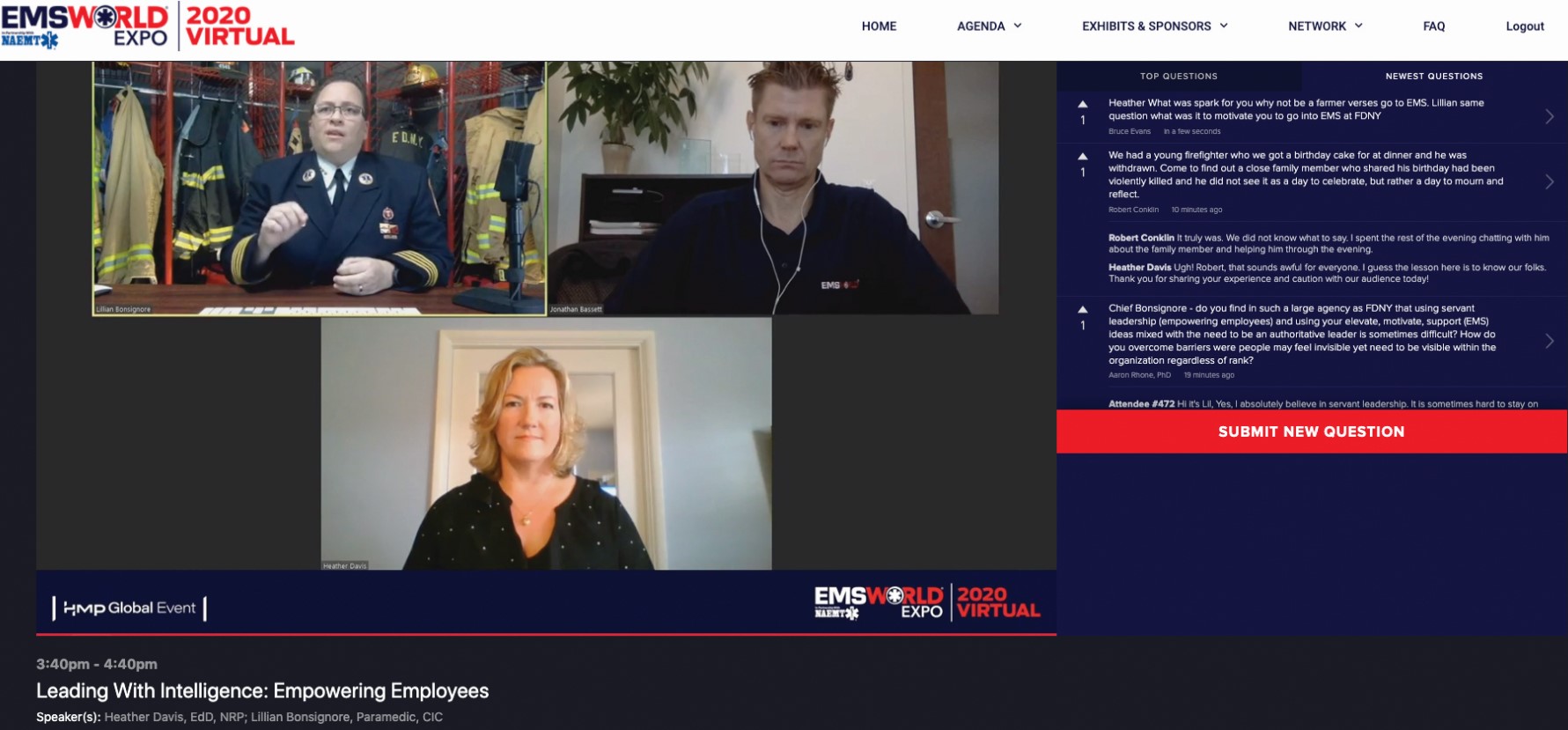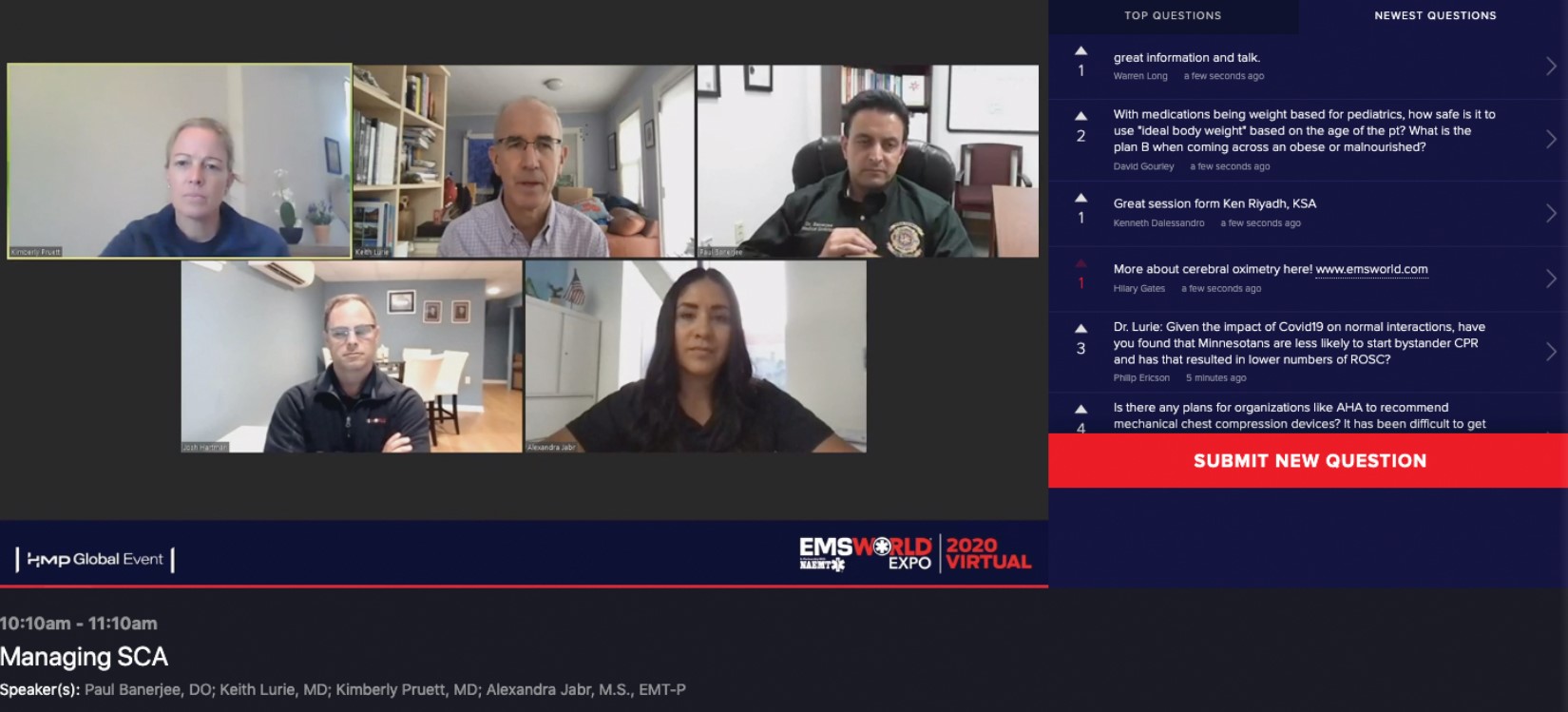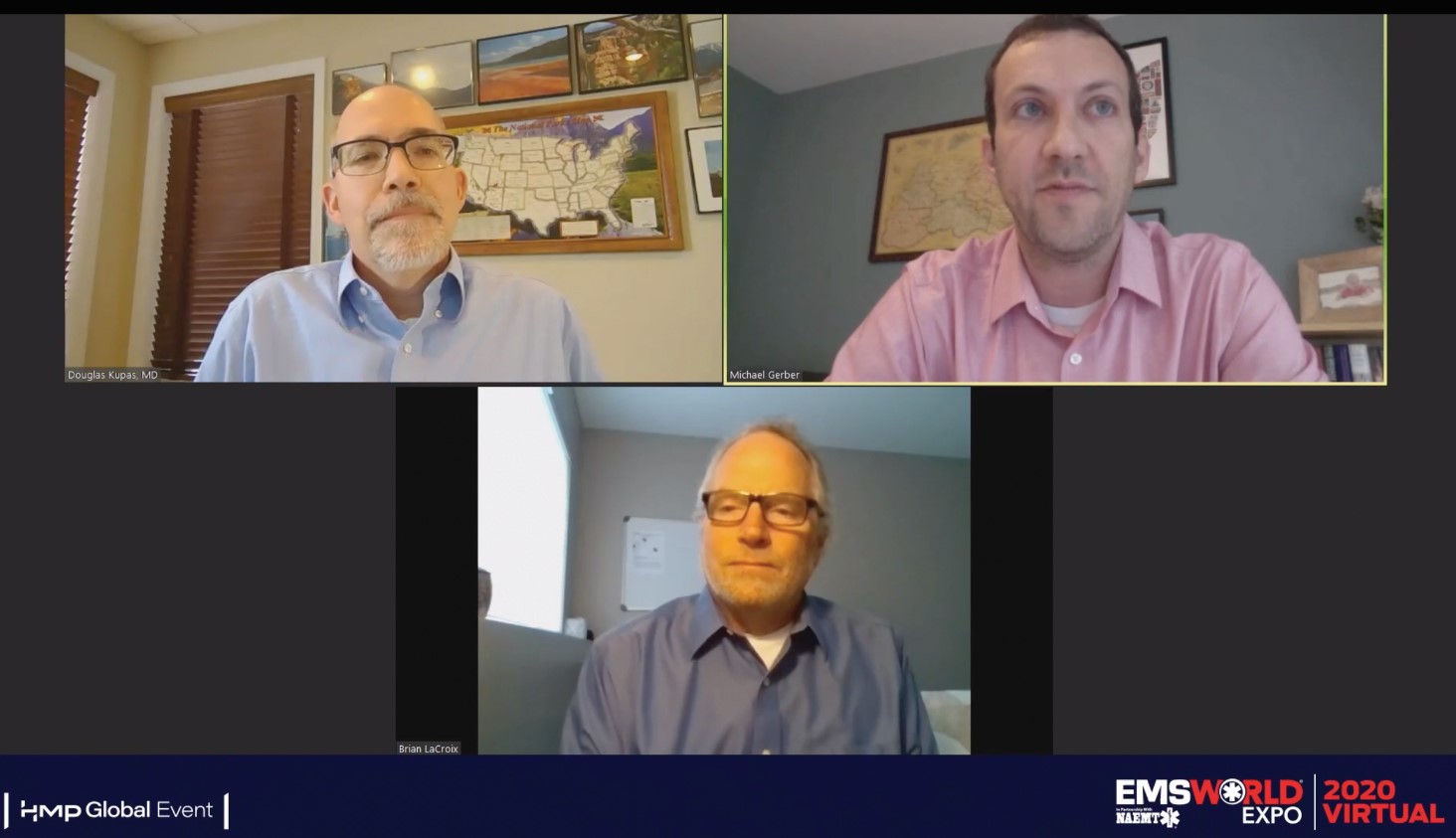ADVERTISEMENT
Highlights of an Unprecedented Expo
There have been 32 EMS and EMS World Expos, but 2020’s might have been the strangest. From speakers delivering by candlelight to Q&As from the road, the show’s unprecedented virtual format brought significant changes and challenges from years past and necessitated a few creative workarounds.
Still, the show was a success that exceeded expectations, with attendance beating goals and smooth-running technology that facilitated the learning. Glitches were few and overcome in appropriate EMS style. Speaker Cynthia Griffin, DO, suffered one when she lost power at her home while recording her session, but she persevered and completed her presentation by the light of flameless candles. Speaker Howard Capon, MPH, was pulled from his live post-session Q&A by call duties but with an assist from his partner was able to phone in from the road to take part. While speakers’ sessions were recorded in advance, the question-and-answer sessions were live, where viewers remained engaged even after sessions ended.
A Living Testament
A virtual year demanded a special kind of keynote, and social media star Dr. Glaucomflecken—the comedic alter ego of Oregon ophthalmologist Will Flanary—delivered an opener that drew broad kudos. In May Flanary experienced a cardiac arrest while sleeping. He shared a recording of his wife’s call to 9-1-1, in which a dispatcher talked her through CPR for 10 minutes before help arrived. Flanary needed six shocks and spent three days sedated in an ICU before awaking with full cognitive function.
When Flanary met his rescue team months following his resuscitation, he emphasized to them the small but vivid gestures that made such a difference to his wife that night: The caring paramedic who first approached her and calmly reassured her it was OK to stop compressions so the team could take over. The provider who took the time to gently close a bedroom door so Flanary’s daughters wouldn’t see what was happening. The EMT who took the time to stay with Kristin and explain the procedures being performed to keep her husband alive.
“I still think about what I say to my kids when I put them to bed at night—just in case I don’t see them again,” concluded Flanary. “I have a newfound immense appreciation for what you all do on a day-to-day basis. Your compassion toward family members who are experiencing the worst day of their lives is something that will never be forgotten. Let me be a living testament to the importance of what you do.” (Read more here.)
Chicago ED Shooting
Events of the summer had violence on everyone’s minds, and one highlight presentation looked at the 2018 mass shooting at Chicago’s Mercy Hospital and Medical Center that claimed three victims, including emergency physician Tamara O’Neal.
O’Neal’s ex-fiancé shot her in the hospital’s parking lot, then entered the emergency department, where he killed a pharmacy resident and a police officer before being shot by police.
Nurse Teri Campbell and Chicago Fire ambulance commander Beth Ciolino described how the 22 patients in the ED at the time were moved to locked closets, recovery rooms, and fast-track areas by nurses, x-ray techs, custodial staff, and security. Chicago Fire commandeered city buses to evacuate less-serious patients while paramedics and nurses took the critical ones to appropriate alternative facilities.
Some lessons learned from the shooting:
- Have a “safe word” for police to identify themselves—hiding staff were initially suspicious when SWAT officers arrived to help them;
- Armed security personnel would have been more effective to intervene;
- Make firm decisions and act. Every minute of indecision adds 10 minutes to overall scene time;
- Stage vehicles far enough away: With 19 ambulances on scene, space outside the hospital got clogged up;
- An initial decision to treat the shooting victims at Mercy led to confusion when there was no staff left on hand to do so.
(Read more here.)
CP Case Studies
A presentation that took good advantage of 2020’s new Zoom framework assembled four experienced community paramedics to work through a pair of challenging case studies using the MIH-CP mnemonic CP’S MERITS. While the mnemonic provides a standardized framework for evaluating the needs of these often-complicated patients, applying it can be subjective, so CPs from San Diego and Santa Fe worked together to gain additional perspectives.
The mnemonic—developed by Dan Swayze, PhD, associate VP for clinical affairs and community support services with the UPMC health plan, and Anne Jensen, EMT-P, special projects manager for San Diego Fire-Rescue—encompasses nine dimensions: clinical, psychological, social support, meals, environment, records, income, transportation, and life-management skills. The Santa Fe Fire Department added a 10th, legal, after experiencing some arrests among its clients, underscoring that the tool is adaptable to local needs and resources. Each dimension is rated as ideal, sustainable, unsustainable, or threatening, with instances of the last two prioritized for action.
The real-life patients considered were a mid-60s female with dementia with severe behavioral and cognitive impairment who’d overdosed repeatedly on Tylenol and a 41-year-old mostly homeless male with TBI-driven impulse-control problems and a chronically painful leg injury that led him to overdose on opiates at least 16 times in 18 months.
See how the panel worked through these difficult cases along with all the rest of 2020’s EMS World Expo presentations through Expo On Demand at www.emsworldexpo.com. (Read more here.)
Other Highlights
A few more highlights from select sessions:
Rural care challenges—St. Luke’s Health System in Magic Valley, Idaho, expedited door-to-needle times for stroke victims through a relocation standby process that lets crews mobilize immediately upon a stroke alert and integrating blood draws into field treatments to eliminate delays at the hospital. In British Columbia COVID-19 has forced BC Emergency Health Services’ community paramedicine program into remote patient visits, but it still seems to be stabilizing 9-1-1 use for select patients in remote areas (almost two-thirds of program patients are in communities of fewer than 3,500 people), with reductions of almost 40% in 9-1-1 calls, 46% in 9-1-1 calls for select chief complaints, and 47% for low-acuity 9-1-1 calls. (Read more here.)
Airways dos and don’ts—Tips for high-performance BLS airway management from flight doc Andrew Latimer included optimal patient positioning (supine or semireclined, with elevation of the head to facilitate intubation), proper mask seal (he favors a two-person approach to the classic one-handed “C-E” grip), and flush-rate preoxygenation—that is, providing as much oxygen as you can. “In the minutes before and during an advanced airway attempt,” Latimer said, “BLS is a critical part of airway management, even if we’re not performing an intervention or critical maneuver.”
Gustavo Flores, MD, outlined three pitfalls of the bag-valve mask: excessive tidal volume (consider holding the bag from the side or just the corner to help limit overventilation); excessive pressure (try a manometer or just using one or two fingers to compress the bag); and lack of focus (don’t multitask). “Just because it’s simple doesn’t mean it’s easy!” said Flores. (Read more here.)
BLS skills and tools—Well-done BLS is critical to many of our patients, including our most critical ones. Educator Gary Heigel offered some simple assessment tips to enhance that care, including using the patient’s name, digging for a good history, not skimping on counting respirations, and conducting a thorough head-to-toe assessment.
Emergency physician Stephanie Louka looked at the function and malfunction of a pair of common EMS tools, the stethoscope and pulse oximeter. Extreme temperatures are a common cause of stethoscope failure, she noted, and pricier isn’t always better, as data have shown cheap disposable stethoscopes can perform as well as top-line products at detecting certain sounds. Carbon monoxide poisoning is a common source of pulse ox failure; if CO-oximeters and multi-wavelength pulse oximeters are too expensive, a simple CO detector attached to the jump bag can warn you of its presence. (Read more here.)
Epidemiology and emergency management—With the pandemic ongoing, a cross-disciplinary panel talked through aspects of EMS/public health interactions. It’s important to “speak public health,” emphasized Pennsylvania Deputy Secretary of Health Ray Barishansky, MPH, to better engage those cross-sector colleagues and understand their roles and capabilities. Public health has received boluses of pandemic funding this year—find out where you fit into its plans.
ImageTrend epidemiologist Morgan Anderson encouraged EMS leadership to have aggregated data available on an ongoing basis, and AirLink/VitaLink’s Kevin Collopy focused on EMS’s role in the emergency operations center. Harvard’s Carl Cowan outlined an alternative “project management” approach to EM that averts some shortcomings of the traditional incident action plan, such as reliance on jargon, lack of options for stakeholder involvement, and lack of a loop to return data to leadership. (Read more here.)
NAEMT Annual Meeting
As it does each year in person, the National Association of EMTs’ general membership meeting also coincided with EMS World Expo in virtual form this year. The organization officially bestowed the National EMS Awards of Excellence on the winners announced in September, and outgoing President Matt Zavadsky delivered the group’s annual report.
With COVID’s requirements of first responders, said Zavadsky, “2020 is perhaps the single most significant year in the entire history of the EMS profession… Communities owe a great debt of gratitude to the paramedics, EMTs, and other prehospital providers who are serving on the front lines of the COVID-19 response.” The National EMS Memorial Service is vetting more than 60 new nominees for potential addition in 2021, including almost 50 related to COVID.
Zavadsky outlined the group’s efforts on behalf of prehospital providers during the pandemic, including outreach to federal sources and advocacy campaigns around areas like PPE, hazard pay, direct relief, and reimbursement for alternative destinations and treatment in place. Among the results: The CDC gave first responders heightened priority for PPE and COVID testing, and CMS agreed to reimburse transport to alternative destinations. However, EMS was left out of the CARES Act’s direct relief, and many services remain in dire financial straits. NAEMT continues to press for treatment-in-place reimbursement, hazard pay, supply chain priority, and EMS relief through disaster grants.
Importantly, the NAEMT saw a whopping increase of 34% in its membership this year. It also bestowed its most prestigious honor, the Rocco V. Morando Lifetime Achievement Award, on Pennsylvania’s commonwealth EMS medical director for the last 20 years, Doug Kupas, MD. (Read more here.)













